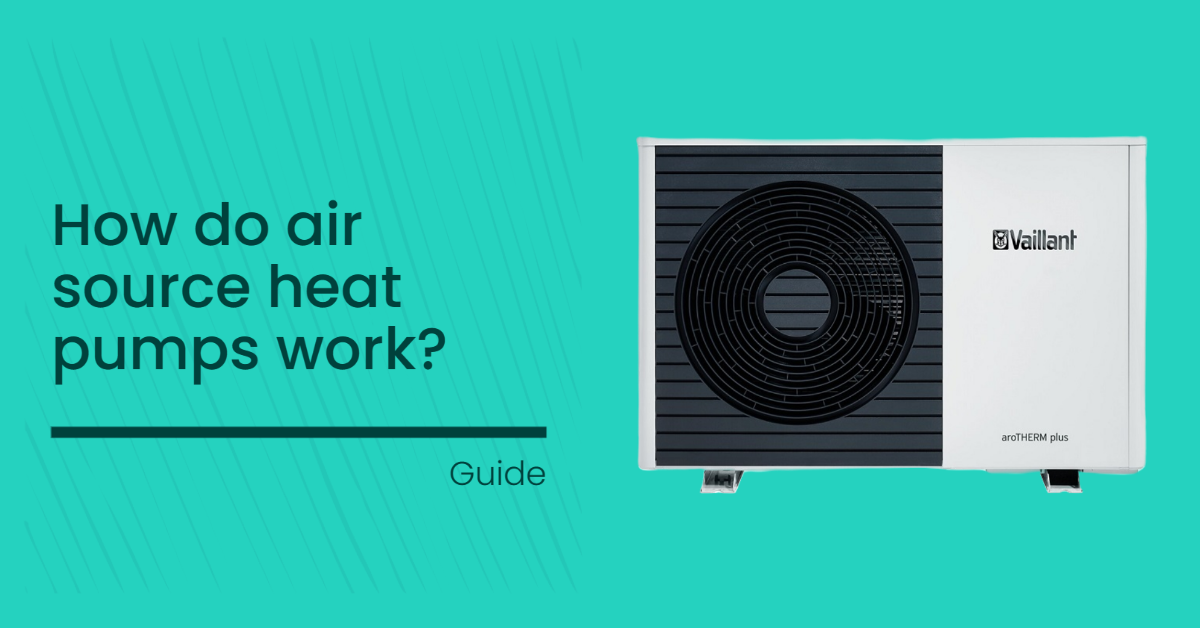How does an air source heat pump work?
This is the burning question, and heat pumps are the hot topic right now for homeowners looking to modernise their heating systems.
So, how do air source heat pumps works? First let’s take a look at one.
This nifty looking box of goodness appears to be very similar to your typical air conditioning units, however I can assure you, it is not.
This is in fact a Vaillant aroTHERM plus heat pump and like many others they look very similar. One side of the housing is a rotary bladed fan allowing the unit gobble up many many cubic metres of fresh air, allowing this rectangular box of magic to carry out it’s ultimate party trick, produce heat from the air around you.
But how does it do that?
Using it’s fan, an air source heat pump can take the ambient air all around us and pass it over a heat exchanger (technically called the evaporator) this then creates a reaction of a refrigerant contained within the evaporator and changes the temperature from low heat to high heat, this then runs through another heat exchanger (technically called the condenser) and is converted in to the heat we use in conventional heating systems.
Hello! Still with us? We don’t want you falling asleep.

How does an air source heat pump work?
This is the burning question, and heat pumps are the hot topic right now for homeowners looking to modernise their heating systems.
So, how do air source heat pumps works? First let’s take a look at one.
This nifty looking box of goodness appears to be very similar to your typical air conditioning units, however I can assure you, it is not.
This is in fact a Vaillant aroTHERM plus heat pump and like many others they look very similar. One side of the housing is a rotary bladed fan allowing the unit gobble up many many cubic metres of fresh air, allowing this rectangular box of magic to carry out it’s ultimate party trick, produce heat from the air around you.
But how does it do that?
Using it’s fan, an air source heat pump can take the ambient air all around us and pass it over a heat exchanger (technically called the evaporator) this then creates a reaction of a refrigerant contained within the evaporator and changes the temperature from low heat to high heat, this then runs through another heat exchanger (technically called the condenser) and is converted in to the heat we use in conventional heating systems.
Hello, still with us? We don’t want you falling asleep now.

Are you looking to have a heat pump installed?
Are you looking to have a heat pump installed?
How are heat pumps efficient?
This is not new technology, you’d be surprised to learn.
The basic principles of a heat pump’s operation have been around for decades, it’s just now that technology has been unlocked to with work the homes of Britain.
Simply an air source heat pump works by using electricity to power a fan and compressor, giving it the fundamental functions to convert heat from the ambient air around us.
Magically, air source heat pumps can work in ambient temperatures as low as minus 20 degrees Celsius.
The secret ingredients for an efficient system?
A great design! We’ll start every installation with a thorough technical plan of action, using crucial data from a technical assessment on the property in question, evaluating the needs of the customer and specifying the correct equipment for the job.

How are heat pumps efficient?
This is not new technology, you’d be surprised to learn.
The basic principles of a heat pump’s operation have been around for decades, it’s just now that technology has been unlocked to with work the homes of Britain.
Simply an air source heat pump works by using electricity to power a fan and compressor, giving it the fundamental functions to convert heat from the ambient air around us.
Magically, air source heat pumps can work in ambient temperatures as low as minus 20 degrees Celsius.
The secret ingredients for an efficient system?
A great design! We’ll start every installation with a thorough technical plan of action, using crucial data from a technical assessment on the property in question, evaluating the needs of the customer and specifying the correct equipment for the job.



